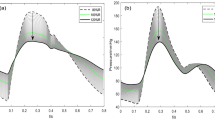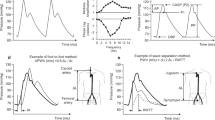Abstract
To evaluate the comparability and reproducibility of the carotid-femoral pulse wave velocity (PWV) measured by the newly developed device compared to that measured by the standard device and the validity of brachial-ankle PWV as a substitute of carotid-femoral PWV. We measured aortic PWV twice in 21 normotensive males by using the standard devices and the newly developed device. We also measured brachial-ankle PWV in the same subjects. There was a strong, significant correlation between aortic (carotid-femoral) PWV measured by using two different devices (r=0.741, P=0.00012). Inter-quartile range of the differences of carotid-femoral PWV measured by Form (0.75 m/s (−0.36, 0.39)) was smaller than that by Complior (1.67 m/s (−1.03, 0.63)). There was no correlation between carotid-femoral PWV, measured by either device, and brachial ankle PWV. Our present results suggest that carotid-femoral PWV measured by using Form was comparable to, and may be more reproducible than, that measured by Complior that has been widely used as a predictable marker for cardiovascular events. Our results also suggest brachial-ankle PWV may not be a substitute for carotid-femoral PWV.
This is a preview of subscription content, access via your institution
Access options
Subscribe to this journal
Receive 12 digital issues and online access to articles
$119.00 per year
only $9.92 per issue
Buy this article
- Purchase on Springer Link
- Instant access to full article PDF
Prices may be subject to local taxes which are calculated during checkout



Similar content being viewed by others
References
Laurent S, Boutouyrie P, Asmar R, Gautier I, Laloux B, Guize L et al. Aortic stiffness is independent predictor of all-cause and cardiovascular mortality in hypertensive patients. Hypertension 2001; 37: 1236–1241.
Blacher J, Guerin AP, Pannier B, Marchais SJ, Safer ME . Impact of aortic stiffness on survival in end-stage renal disease. Circulation 1999; 99: 2434–2439.
Cruickshank K, Riste L, Anderson SG, Wright JS, Dunn G, Gosling RG . Aortic pulse-wave velocity its relationship to mortality in diabetes glucose intolerance. An integrated index of vascular function? Circulation 2002; 106: 2085–2090.
van Popele NM, Grobbee DE, Bots ML, Asmar R, Topouchian J, Reneman RS et al. Association between arterial stiffness and atherosclerosis. The Rotterdam study. Stroke 2001; 32: 454–460.
Asmar R, Topouchian J, Pannier B, Benetos A, Safar M . Scientific, Quality Control, Coordination Investigation Committees of the Complior Study. Pulse wave velocity as endpoint in large-scale intervention trial. The Complior study. J Hypertens 2001; 19: 813–818.
Asmar R, Bonetos A, Topouchian J, Laurent P, Pannier B, Brisac A-M et al. Assessment of arterial distensibility by automatic pulse wave velocity measurement. Validation and clinical application study. Hypertension 1995; 26: 485–490.
Narimatsu K, Takatani S, Ohmori K . A multi-element carotid tonometry sensor for non-invasive measurement of pulse wave velocity. Fron Med Biol Eng 2001; 11: 45–58.
Munakata M, Ito N, Nunokawa T, Yoshinaga K . Utility of automated brachial ankle pulse wave velocity measurements in hypertensive patients. Am J Hypertens 2003; 16: 653–657.
McDonald DA . Regional pulse wave velocity in the arterial tree. J Appl Physiol 1968; 24: 73–78.
Yamashina A, Tomiyama H, Takeda K, Tsuda H, Arai T, Hirose K et al. Validity, reproducibility, and clinical significance of non-invasive brachial-ankle pulse wave velocity measurement. Hypertens Res 2002; 25: 359–364.
Bland JM, Altman DG . Statistical methods for assessing agreement between two methods of clinical measurement. Lancet 1986; 1 (8476): 307–310.
Petrie JR, Ueda S, Morris AD, Murray LS, Elliott HL, Connell JMC . How reproducible is bilateral forearm plethymography? Br J Clin Pharmacol 1998; 45: 131–139.
Laurent S, Cockcroft J, Van Bortel L, Boutouyrie P, Giannattasio C, Hayoz D et al., on behalf of the European Network for Non-Invasive Investigation of Large Arteries. Expert consensus document on arterial stiffness: methodological issues and clinical applications. Eur Heart J 2006; 27: 2588–2605.
Kubo T, Miyata M, Minagoe S, Setoyama S, Maruyama I, Tei C . A simple oscillometric technique for determinig new indices of arterial distensibility. Hypertens Res 2002; 25: 351–358.
Kimoto E, Shoji T, Shinohara K, Inaba M, Okuno Y, Miki T et al. Preferential stiffening of central over peripheral arteries in type 2 diabetes. Diabetes 2003; 52: 448–452.
Acknowledgements
We thank Junko Yokouchi RN for her technical assistance. This work was supported in part by a grants-inaid from the Ministry of Education, Science and Culture, Japan (no. 16590439 and no. 19590541 for S Ueda).
Author information
Authors and Affiliations
Corresponding author
Additional information
Conflict of interest
None.
Rights and permissions
About this article
Cite this article
Ueda, I., Tagawa, T., Watanabe, S. et al. Comparability and reproducibility of the carotid-femoral pulse wave velocity measurements using a multi-element carotid tonometry sensor. J Hum Hypertens 22, 699–703 (2008). https://doi.org/10.1038/jhh.2008.57
Received:
Revised:
Accepted:
Published:
Issue Date:
DOI: https://doi.org/10.1038/jhh.2008.57
Keywords
This article is cited by
-
Validity and repeatability of the Vicorder apparatus: a comparison with the SphygmoCor device
Hypertension Research (2009)



